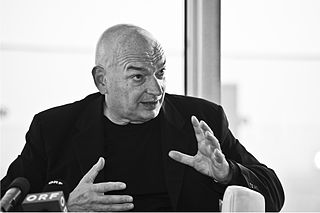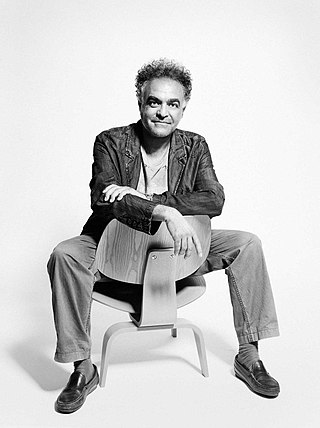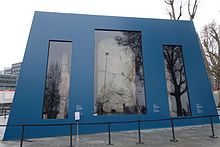
Brise soleil, sometimes brise-soleil, is an architectural feature of a building that reduces heat gain within that building by deflecting sunlight. The system allows low-level sun to enter a building in the mornings, evenings and during winter but cuts out direct light during summer.

The Musée du Quai Branly – Jacques Chirac, located in Paris, France, is a museum designed by French architect Jean Nouvel to feature the indigenous art and cultures of Africa, Asia, Oceania, and the Americas. The museum collection comprises more than a million objects, of which 3,500 are on display at any given time, in both permanent and temporary thematic exhibits. A selection of objects from the museum is also displayed in the Pavillon des Sessions of the Louvre.
The Prix d'architecture de l'Équerre d'argent is a French architecture award. This prize was launched in 1960 by "Architecture Française" magazine and its director Michel Bourdeau.

The Louvre Abu Dhabi is an art museum located on Saadiyat Island in Abu Dhabi, United Arab Emirates. It runs under an agreement between the UAE and France, signed in March 2007, that allows it to use the Louvre's name until 2047, and has been described by the Louvre as "France's largest cultural project abroad." It is approximately 24,000 square metres (260,000 sq ft) in size, with 8,000 square metres (86,000 sq ft) of galleries, making it the largest art museum in the Arabian Peninsula. Artworks from around the world are showcased at the museum, with stated intent to bridge the gap between Eastern and Western art.

Henry Laurens is a French historian and author of several histories and studies about the Arab-Muslim world. He is Professor and Chair of History of the Contemporary Arab world at the Collège de France, Paris.

Jean Nouvel is a French architect. Nouvel studied at the École des Beaux-Arts in Paris and was a founding member of Mars 1976 and Syndicat de l'Architecture, France’s first labor union for architects. He has obtained a number of prestigious distinctions over the course of his career, including the Aga Khan Award for Architecture, the Wolf Prize in Arts in 2005 and the Pritzker Prize in 2008. A number of museums and architectural centres have presented retrospectives of his work.

Youssef Nabil was born on the 6th of November 1972. He is an Egyptian artist and photographer. Youssef Nabil began his photography career in 1992.
The Grands Projets of François Mitterrand was an architectural programme to provide modern monuments in Paris, the city of monuments, symbolising France's role in art, politics and the economy at the end of the 20th century. The programme was initiated by François Mitterrand, the 21st President of France, while he was in office. Mitterrand viewed the civic building projects, estimated at the time to cost the Government of France 15.7 billion francs, both as a revitalisation of the city, as well as contemporary architecture promoted by Socialist Party politics. The scale of the project and its ambitious nature was compared to the major building schemes of Louis XIV.

Huguette Caland was a Lebanese painter, sculptor and fashion designer known for her erotic abstract paintings and body landscapes. Based out of Los Angeles, her art was displayed in numerous exhibitions and museums around the world.
Nadim Asfar is a French-Lebanese photographer and filmmaker. He currently lives and works between Paris and Beirut. He studied cinematography at the Académie Libanaise des Beaux-Arts ALBA Beirut and then photography at the École Nationale Supérieure Louis Lumière (Paris) before engaging in the theory of arts and languages at the École des Hautes Études en Sciences Sociales.
ShaficAbboud was a Lebanese painter. He studied at the Académie Libanaise des Beaux-Arts ALBA and left to Paris in 1947. Although he spent most of his life in France, he is considered as one of the most influential Lebanese artists of the 20th century.
Gilbert Hage is a Lebanese photographer. He studied at the Université Saint-Esprit de Kaslik and teaches there since 1990. He also teaches at the Académie Libanaise des Beaux-Arts ALBA. He sometimes collaborates with curator and researcher Ghada Waked, his wife, and is co-publisher and co-editor, with Jalal Toufic, of Underexposed Books.

Nadim Karam ; is a multidisciplinary Lebanese artist and architect who fuses his artistic output with his background in architecture to create large-scale urban art projects in different cities of the world. He uses his vocabulary of forms in urban settings to narrate stories and evoke collective memory with a very particular whimsical, often absurdist approach; seeking to 'create moments of dreams' in different cities of the world.

Mahmoud Obaidi is an Iraqi-Canadian artist whose work has been exhibited in museums and galleries around the world.
The Prix du roman arabe of the "Council of Arab Ambassadors" is a French literary award established in 2008.

Warrior by a Tomb, Arab by a Tomb or The Arab by the Tomb is an 1838 oil-on-canvas painting by the French artist Eugène Delacroix, now in the Hiroshima Museum of Art. It was inspired by his trip to Morocco in 1831 as an official painter. The painting was refused by the jury of the Paris Salon in 1838.
The Grand Louvre refers to the decade-long project initiated by French President François Mitterrand in 1981 of expanding and remodeling the Louvre – both the building and the museum – by moving the French Finance Ministry, which had been located in the Louvre's northern wing since 1871, to a different location. The centerpiece of the Grand Louvre is the Louvre Pyramid designed by Chinese-American architect I. M. Pei, which was also the project's most controversial component. The Grand Louvre was substantially completed in the late 1990s, even though its last elements were only finalized in the 2010s.
Mohamed El Aziz Ben Achour is a Tunisian politician and historian born on 5 January 1951; he specializes in urban, social and cultural history of modern Tunisia and the Islamic civilization. He was the Minister of Culture some time between 2004 and 2008, and later Director-General of the Arab League Educational, Cultural and Scientific Organization (ALECSO) some time between 2009 and 2013.
Mona Khazindar is a Saudi-American art historian and curator. She was the Director General of the Institut du Monde Arabe from 2011 to 2014.
















